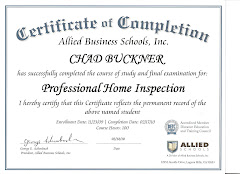1. Clean the House
This sounds so simple yet home owners often overlook this tactic. Home inspectors are people first and inspectors second. As people, they carry preconceived ideas of how well a home has been maintained. Clean homes say you care and take care of the house.
2. Be On Time Because the Inspector Will Be
Sometimes home inspectors are early. If an inspector makes an appointment with you for 9:00 a.m., have the house ready for inspection at 8:30. It's also common for inspectors to start on the exterior of the home, so leave the shades down or drapes drawn until you are dressed. More than one unprepared seller has been "surprised" by a stranger stomping around in the back yard.
3. Leave the Utilities Connected
The home inspector will need to turn on the stove, run the dishwasher, test the furnace and air conditioning, so leave the utilities on, especially if the house is vacant. It's impossible to check receptacles for grounding and reverse polarity if the power is turned off. Without utilities, the inspector will have to reschedule, which could delay the closing of your transaction and the removal of the buyer's home inspection contingency.
4. Provide Workspace Around Furnace and Water Heaters
Remove boxes, bookcases, furniture and anything else blocking access to your furnace, air conditioner and water heater. The inspector will need three to four feet of working space to inspect these items.
5. Keep Pilot Lights Ignited
Many home inspectors will refuse to light pilot lights because they are not covered for that type of liability. If your pilot lights are not lit, then important items such as the water heater, gas stove or furnace will not be inspected and the buyer could delay closing until those inspections are completed.
6. Provide Access to Attic and Garage
The inspector will need to get into your basement and / or attic as well, so keep a path cleared. Move boxes away from the walls. Vacuum spider webs.
7. Leave Keys for Outbuildings & Electrical Boxes
Leave the remote controls for your garage door opener or a key if the garage is unattached to the house. Unlock the covers for your sprinkler system and electrical box. Leave a key for exterior building access.
8. Clear Away Brush from Exterior Inspection Points
Nobody expects you to shovel a tunnel around your home if snow drifts are blocking the foundation but, in the winter, do provide a path around the house. In the summer, cut down dead tree branches and clear brush from the foundation. Move trash cans away from the house.
9. Provide Repair Documents
Make available to the home inspector all invoices and documents regarding remodeling projects or new items such as a roof or furnace. If you've upgraded the electrical from ungrounded to grounded, installed a new dishwasher or repaired a leaky faucet, find the paperwork. It will give the buyer peace of mind to know those items were reinspected.
10. Prepare to be Away for Three Hours Minimum
Often the buyer will accompany the home inspector, and buyers feel uncomfortable asking questions if the owner is present. Try to schedule a time for the inspection when you can be out of the house, and take the children with you. Crate your pets if you cannot remove them from the premises.
(about.com)

Serving The Utah Wasatch Front Area
______________________________________________
Welcome to Buckner Home Inspections
Contact Info
Blog Archive
